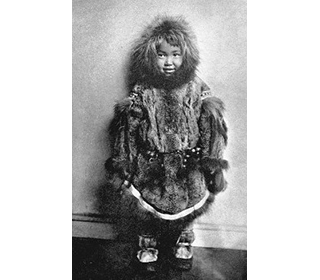The name Mukluk is derived from the Yupik word 'maklak' meaning "bearded seal" in reference to the bearded-seal skin that was used to make the soles of boots. Mukluks were traditionally made using distinctive furs, leather and adornments to reflect the individual customs and culture of the indigenous tribes of Alaska. Mukluks Fact Sheet - Mukluks Fact 1: The earliest versions of mukluks were made from sealskin (mostly bearded seal), moose or caribou hide for the soles and leg uppers. The fur used to insulate the boots was primarily made of squirrel, bear or beaver
- Mukluks Fact 2: The fur-coated, lightweight mukluk boot was worn for warmth and mobility in the arctic environment in sub-zero temperatures
- Mukluks Fact 3: Moccasins were the warm-weather alternative to Mukluks, and worn by Native American tribes who lived farther south. The process and method for for making both types of footwear were very similar
- Mukluks Fact 4: Mukluks were known as kamiks amongst the Inuit people
- Mukluks Fact 5: The women of the tribes were skilled at making Mukluks for the whole family. Each woman possessed a tool kit containing the tools required to construct the Mukluk boot and the skin garment (layers) by hand
- Mukluks Fact 6: Many steps and processes were required to make the boots including cutting, scraping, softening and working the skins, sewing, decorating the skins and adding ornamental adornments to the Mukluks such as tassels, beading and pom-poms
- Mukluks Fact 7: A woman's sewing bag or box included an ulu (knife), scraper, scraping board and needles
- Mukluks Fact 8: The original tools used by the women to make the Mukluks were made from horns, antlers, bones and wood. The sewing and stitching was done using needles made of ivory or bone.
- Mukluks Fact 9: Caribou sinew was used as thread
- Mukluks Fact 10: The Alaskan Athabaskan, who inhabited interior regions of Canada and Alaska, made their mukluks moose hide and trimmed them with fur and beadwork
- Mukluks Fact 11: A baby's Mukluk boots were always made with the fur inside but were otherwise a similar design to adult boots
- Mukluks Fact 12: An ankle-high mukluk was used as a house slipper
- Mukluks Fact 13: Mukluk boots worn by the women were often decorated with trims and tassels. The footwear of the men lacked decorative trimming as they were needed for highly practical purposes when hunting and working outdoors. The flexible, lightweight boots were ideal for hunting and fishing
- Mukluks Fact 14: Mukluks were often styled with different patterns identifying the geographic area that the wearer came from
- Mukluks Fact 15: Traditionally the Mukluk boots worn by men and boys from the from the Eastern Arctic regions had vertical patterns, whereas the boots worn by the women and girls had horizontal patterns
- Mukluks Fact 16: The tribes wore layers of footwear made from caribou fur, including liners and inner boots which provided insulation to keep warm
- Mukluks Fact 17: Layers of footwear were worn under the Mukluks depending on the temperature, the conditions of the ground and activities the people needed to perform.
- Mukluks Fact 18: Sealskin to make the Mukluks came from the harp seal, ringed seal or bearded seals. Sealskin was strong and almost waterproof and was and ideal material for making boots
- Mukluks Fact 19: How to make Mukluk boots:
- The blubber and hair was removed from the seal skins
- The skins were then washed and softened by pummelling, stretching and kneading
- Scrapers are used to press out the excess water and fat to make the skin pliable. The skin was placed over a wooden frame for the scraping and stretching process
- The leather would become hard and shrink if it became wet so the skin was often smoked. Smoking sealed the fibers of the hide, thereby preventing them from shrinking and hardening
- The soft and pliable leather was then cut to shape and sewn with hand-twisted thread made from sinew
- Holes were punched into the leather with a bone tool called an awl
- The hard soles of the boots and leg uppers were generally made from two pieces of leather with a side or center seam
- The piece of leather called a vamp was added as the part of the mukluk that stretched across the top of the foot
- The boot was embellished with a variety of decorations including tassels, fur, bead work and painted designs
- Mukluks Fact 20: Modern methods and materials have been combined with the traditional mukluk design to produce a variety of Mukluk style products
For additional facts about Artic clothing refer to Fur Parkas. |
